H12-261 : HCIE-R&S (Written) (Huawei Certified Internetwork Expert-Routing & Switching) : Part 09
-
Which of the following statements regarding BGP route summarization is true? (Choose two.)
- Routes in the local BGP routing table can be manually aggregated.
- After the aggregate ipv4-address mask command is configured, only summary routes are advertised and specific routes are not advertised.
- By default, automatic BGP route summarization is enabled.
- BGP supports manual aggregate and automatic summarization of IPv6 routes.
-
The IS-IS overload bit is set on R3. Which of the following statements are true? (Choose three.)
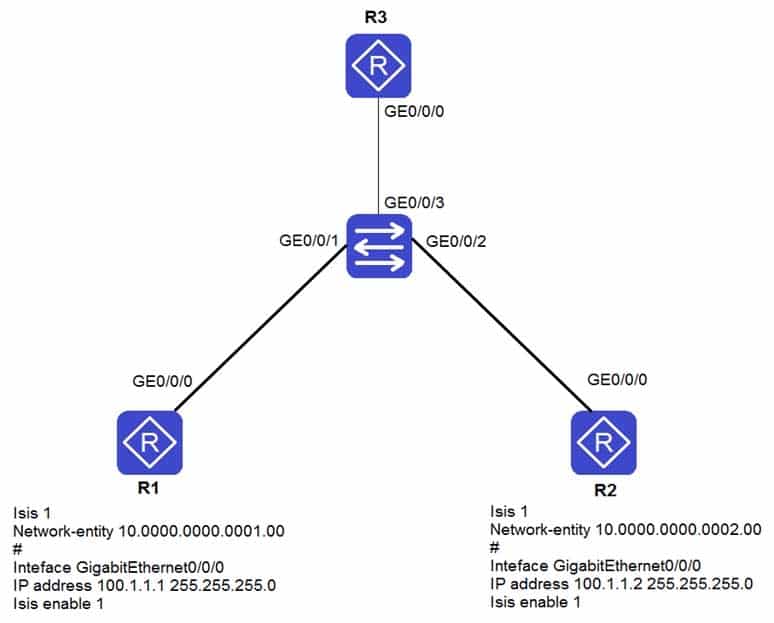
H12-261 HCIE-R&S (Written) (Huawei Certified Internetwork Expert-Routing & Switching) Part 09 Q02 026 - Before the timeout of the overload timer on R3, R1 and R2 do not add the LSPs generated by R3 to the SPF tree.
- The direct route of R3 is ignored by R1 and R2 due to the setting of the overload bit.
- LSPs of R3 cannot be flooded to R1 and R2.
- Routes imported to R3 through the import-route command cannot be advertised.
- When a router is experiencing a memory shortage, the system automatically sets the overload bit in the sent LSPs regardless of whether you have the set-overload command.
-
Which of the following statements regarding CHAP authentication in the PPP protocol are true? (Choose three.)
- If no user name is configured for the authenticated party, the password does not need to be configured on the interface of the authenticated party.
- The MD5 algorithm is used to calculate a hash based on the authentication sequence ID, a random number, and the key.
- Authentication requires three-way handshake. Only the user name is transmitted on the network, not the password.
- The user name must be configured on the interface of the authenticated party.
-
Which of the following statements regarding 802.1s deployment is true?
- Multiple bridges share a spanning tree instance.
- Each VLAN owns a spanning tree instance.
- Multiple VLANs share a spanning tree instance.
- All VLANs share a spanning tree instance.
-
Based on the key configurations, as shown in the figure, R1 and R2 establish a Level-2 neighbor relationship. Which of the following statements regarding routing entries on R2 are true?
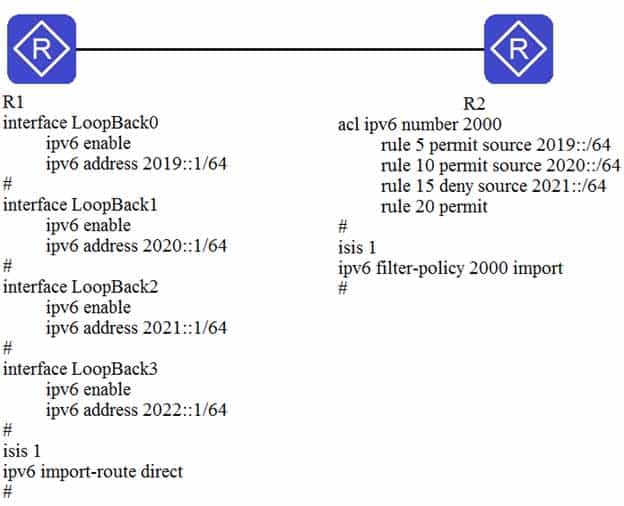
H12-261 HCIE-R&S (Written) (Huawei Certified Internetwork Expert-Routing & Switching) Part 09 Q05 027 - 2020:: /64 will be displayed in the IP routing table.
- 2021:: /64 will be displayed in the IP routing table.
- 2019:: /64 will not be displayed in the IP routing table.
- 2022:: /64 will not be displayed in the IP routing table.
-
For Huawei S series switches, to control which member switch becomes the master switch of a stack, first power on the switch you wish to be the master switch, and then wait 20 seconds before powering on the other member switches.
- TRUE
- FALSE
-
A network with the typology shown in the figure below is set up in a lab. On the network, SW1 uses the default configurations, and STP disables on SW2. Given this information, which of the following statements is true?
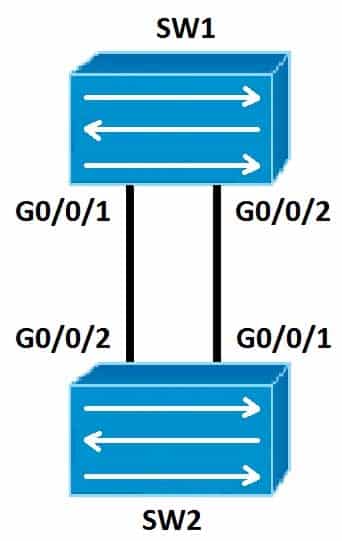
H12-261 HCIE-R&S (Written) (Huawei Certified Internetwork Expert-Routing & Switching) Part 09 Q07 028 - Go/0/2 of SW2 enters the Discarding state.
- G0/0/1 of SW1 enters the Discarding state.
- G0/0/1 of SW2 enters the Discarding state.
- No interface is blocked.
- G0/0/2 of SW1 enters the Discarding state.
-
Huawei switches SWA and SWB are connected through seven physical Ethernet links and are configured with static link aggregation. On SWA, the interface and are configured in the following sequence: Ethernet 1/0/1, Ethernet 1/0/2, Ethernet 1/0/3, Ethernet 1/0/4, Ethernet 1/0/5, Ethernet 1/0/6,
Ethernet 1/0/7. If only six ports are supported in a LAG on SWA and SWB, which of the following statements is true?
- If the configurations of different ports are consistent, SWA selects one of the seven ports at random to be the Unselected port of the LAG.
- If the configurations of different ports are consistent, Ethernet 1/0/6 is the Unselected port of the LAG.
- If the configurations of different ports are consistent, Ethernet 1/0/7 is the Unselected port of the LAG.
- If the configurations of different ports are consistent, Ethernet 1/0/1 is the Unselected port of the LAG.
-
An MSTP switch considers an RSTP switch to be an MSTP region that consists of only one switch and parses RST BPDUs into MST BPDUs, in which IRPC is 0.
- TRUE
- FALSE
-
On an RSTP-enabled switch, if the network topology changes, which of the following statements regarding changes to the Layer 2 forwarding entries learned by the switch is true?
- All entries, apart from the entries related to edge ports, are deleted.
- If the aging time is set to 15 seconds, all the aged entries are deleted.
- All entries, apart from the entries related to edge ports and the entries related to the port that receives the TC BPDU, are deleted.
- All entries are deleted.
- Only the entries related to the port that receives the TC BPDU are deleted.
-
The figures below show an enterprise’s Layer 2 networking architecture and information displayed when engineers check the device status after communication between departments fails.
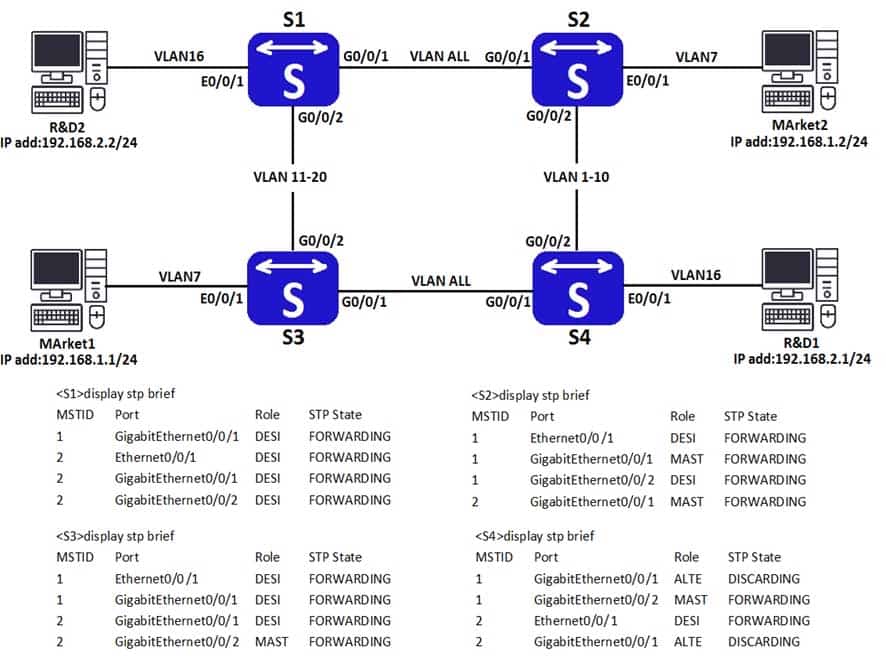
H12-261 HCIE-R&S (Written) (Huawei Certified Internetwork Expert-Routing & Switching) Part 09 Q11 029 What are the possible causes of this communication failure?
- The switches have different region names.
- The switches have different instance-VLAN mapping configurations.
- The switches have different revision levels.
- The switches have different BPDU sending intervals.
-
You are performing troubleshooting on a LAN and suspect that the error is caused by mismatching working modes.
Which of the following switch interface errors indicate that the working modes of the 10/100/1000 Ethernet interfaces do not match?
- Alignment error
- Excessive collisions
- Undersized frame
- Late collisions
- FCS error
-
The ip ip-prefix ip-prefix-name [ index index-number ] {permit | deny} ipv4 address mask-length [ greater-equal greater-equal-value ] [ less-equal- less-equal-value ] command is used to configure an IP prefix list for route filtering.
If the less-equal parameter of an IP prefix list is specified in this command but the greater-equal parameter is not specified, what is the range of the created IP prefix list?
- [mask-length, less-equal-value]
- [less-equal-value, 32]
- Unlimited
- [0, less-equal-value]
-
An OSPF router is connected to Area 0 and Area 1, and Area 1 is configured as a stub area.
Which type of LSAs are in Area 1?
- Type 1, Type 2, and Type 5 LSAs
- Type 1, Type 2, and Type 3 LSAs
- Type 3 and Type 4 LSAs
- Type 7 LSA
- Type 1 and Type 2 LSAs
-
According to the following scenario, which of the following statements are true?
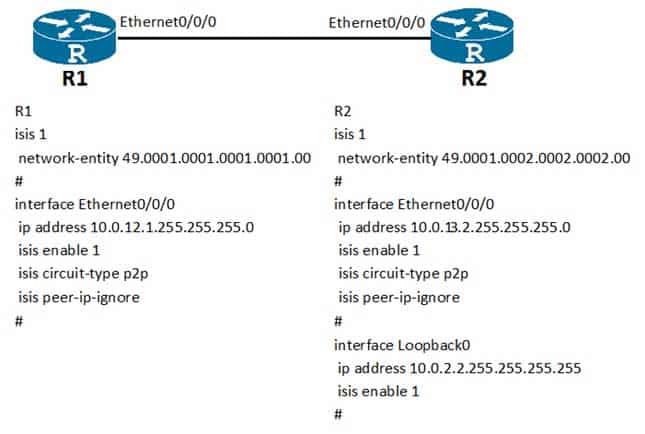
H12-261 HCIE-R&S (Written) (Huawei Certified Internetwork Expert-Routing & Switching) Part 09 Q15 030 - R1 and R2 cannot establish a neighbor relationship.
- R1 has both Level-1 and Level-2 LSDBs.
- R1 has a route to the IP address 10.0.2.2/32 of loopback0 on R2.
- R1 can successfully ping the IP address of loopback0 on R2.
-
Which of the following statements regarding OSPFv3 Router-LSAs is true?
- The data part of a Router-LSA contains the interface IDs of the local router and its neighbors’ router ID.
- When LS type in the LSA header is 0x0001, the data part of the LSAs is a Router-LSA.
- Similar to OSPFv2, the Option field exists in an LSA header rather than the data part of a Router-LSA.
- The data part of a Router-LSA contains the link-local address.
-
According to the figure shown and assuming that IPv6 is enable on ISIS process of all routers, R1, R2, and R3 establish Level-2 neighbor relationships. Which of the following statements regarding the IP routing table of R3 are true? (Choose all that apply.)
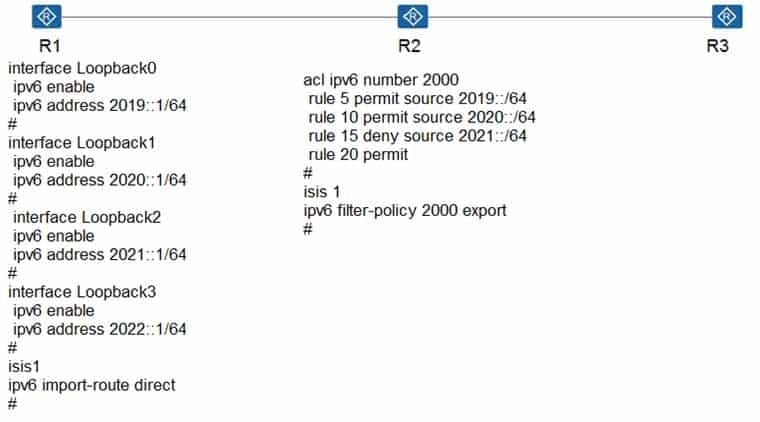
H12-261 HCIE-R&S (Written) (Huawei Certified Internetwork Expert-Routing & Switching) Part 09 Q17 031 - 2019::/64 will be displayed in the IP routing table
- 2020::/64 will be displayed in the IP routing table
- 2021::/64 will be displayed in the IP routing table
- 2021::/64 will be displayed in the IP routing table
-
Which of the following statements regarding OSPFv3 is false?
- Multiple instances can be run on a single link.
- Each OSPFv3 process runs independently in a router.
- The OSPFv3 packet header contains the Instance ID field.
- Multiple instances can be run in the same OSPFv3 process on an interface.
-
Router HW1 runs BGP, and has IBGP peers and EBGP peers configured.
Which of the following statements regarding the IBGP peers and EBGP peers are true?
- The router sends BGP updates learned from each IBGP peer to the other IBGP and EBGP peers.
- The IBGP peers must be directly connected. Otherwise, multi-hop IBGP must be configured on the router.
- The EBGP peers can establish peer relationships through loopback interfaces.
- The router sends BGP updates learned from each EBGP peer to the other EBGP and IBGP peers.
- The EBGP peers must be directly connected. Otherwise, multi-hop EBGP must be configured on the router.
-
Which of the following statements regarding IS-IS GR is true?
- A new TLV is defined to support IS-IS GR.
- IS-IS GR is enabled by default.
- IS-IS GR uses four timers.
- IS-IS GR uses CSNPs for event notification and neighbor relationship maintenance.
Subscribe
0 Comments
Newest